This Insurance Issues:
- reports on the 2011 insurance program and policy revisions
- reviews statistics on claims and potential claims
- explains the policy’s free discovery period coverage for lawyers leaving practice
- reports on 10 years of feedback from insureds on the services we provide
The Lawyers Insurance Fund manages the Law Society’s insurance program for BC lawyers. The program provides insurance for negligence (Part A of the policy) and theft (Part B of the policy).
Insurance assessment
Although the economic landscape remains challenging, there is only a nominal increase in the insurance fee for 2011. Last year, the fallout from the recession necessitated a modest increase in the fee for the first time in 17 years. As a result of the increased cost of claims and the negative impact on the Fund’s investments, the fee increased $200. This year, economic pressures continue to adversely affect claims and investment returns, however, thanks to the adjustment made last year, the Benchers approved a fee increase of only $150, setting the 2011 assessment at $1,750.
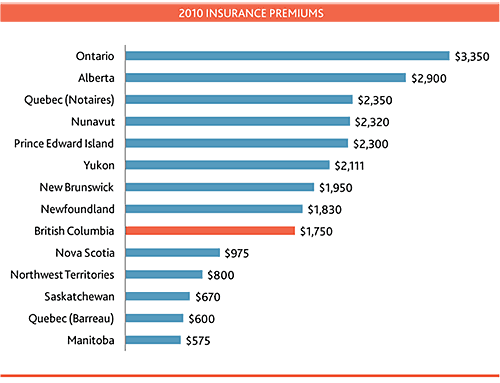
The upward trend in fees noted last year among the other Canadian jurisdictions continues. In fact, lawyers in all of the Western provinces, as well as those in Ontario, Nova Scotia, Nunavut, the Yukon and Québec (notaires), are paying more this year for insurance. Our fee, however, remains low, particularly when compared with the two other larger programs, Ontario and Alberta. And unlike other programs, our policy insures lawyers for both negligence and theft, through Part B trust protection coverage. With no separate assessment being levied for Part B in 2011 and the Special Compensation Fund fee dropping to $5, the Law Society is effectively managing its commitment to protect innocent victims of lawyer theft at no additional cost to lawyers.
Compulsory policy wording
For 2011, the consolidated policy issued in 2010 is renewed by endorsement. This year brings only a few changes to the policy wording, made to clarify the policy’s intent.
The definitions of damages for both Part A and Part B now provide that damages do not include “any order for costs or indemnification for costs made against you in litigation in which you are not a party, or any order for special costs.” The revisions clarify that the policy does not respond to cost orders made as a result of a lawyer’s reprehensible conduct, whether pursuant to a specific Rule or the court’s inherent jurisdiction.
In 2010, revisions were made to Insuring Agreement A2 to better reflect the responsibility of lawyers to pay some portion of defence costs in litigation that involves covered as well as uncovered allegations or claims. For 2011, Insuring Agreement A2.4 is amended by replacing the word “action” with “arbitration.” Although agreements are usually reached in relation to cost-sharing, any disputes will now be determined through arbitration. As a result, Condition 18 also required revision.
Exclusion 7 operates to exclude coverage for in-house lawyers, as these lawyers do not participate in the compulsory program. Over the years, various exceptions were created to allow trade union, society and public legal service lawyers to buy the policy, if they chose, for protection for certain claims. Those exceptions to the exclusion, earlier set out in Exclusions 7.2 through 7.4, and are now tidied up and dealt with in one exception, a revised 7.2. The changes also build in some expanded coverage for trade union and society lawyers, as they are now insured for claims brought against them by anyone, not just members or employees of the trade union or society, as long as the claim is not brought by or on behalf of their employer.
The reporting obligation set out in Condition 4.1 now references Claims Manager, Kate Jenkins.
Condition 5.1.1 is amended to clarify that, upon request, lawyers will provide us with information and documents as well as written statements, either for determining or reviewing coverage. The amendments clarify that a lawyer’s duty to cooperate includes providing us information and documents, either initially or during the course of a file, to assist us in determining if coverage is in order.
The second sentence of Condition 5.4, protecting claims information from disclosure, is reordered for clarity.
The 2011 endorsement was included with the December 2010 Member’s Manual amendment package. Other policies and endorsements issued since 1999 are available in the Insurance section of the Law Society’s website.
Rreview of claim and potential claim reports
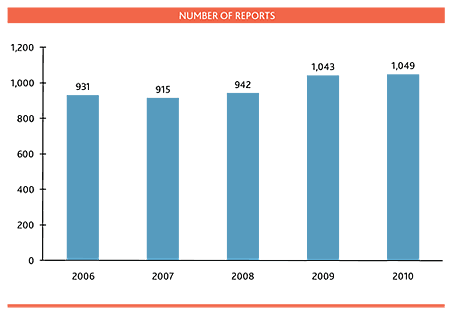
Part A (negligence)
The chart Number of reports shows the number of reports over the past five years. Reports include both claims and potential claims. The numbers are consistent with our previous experience of increased claims activity following a recession.
The following two charts provide more information about the specific claims experience in 2010 by area of law. The first chart shows the percentage of reports generated by the different areas of practice. Civil litigation – plaintiff and Motor vehicle – plaintiff continue to account for almost a third of all reports, not unexpected given the risk practitioners in these areas face of missing a deadline or a “settler’s remorse” claim.
The second chart shows the areas of practice according to the actual or expected cost of reports. And the trends in severity that began in 2009 as a result of the economic downturn, worsened in 2010 with conveyancing and commercial areas of law accounting for almost two-thirds of all dollars spent or reserved.
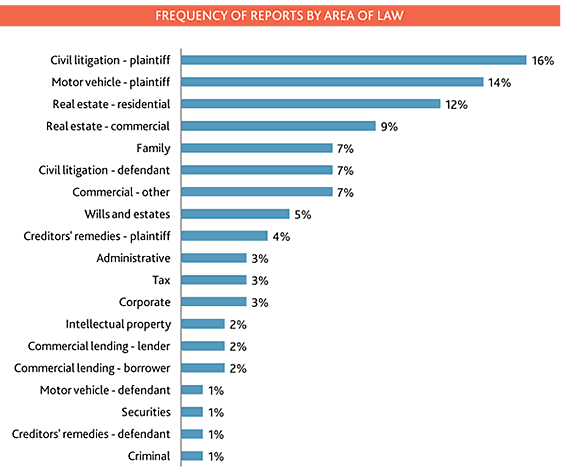
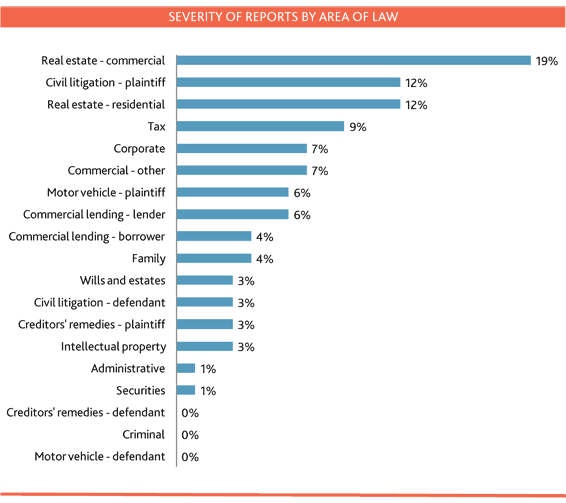
Part B (theft)
Since this coverage was introduced in May 2004, there have been 136 reports of claims and potential claims involving 55 lawyers. However, in many of these reports the claim is without merit, and our claims experience continues to demonstrate that only a very small number of lawyers are involved in misappropriations.
In 2010, 18 claims were paid on behalf of 6 different lawyers, totaling approximately $270,000. Details of these claims follow:
- A payment of $1,278 was made on behalf of a lawyer retained to act in a lease dispute. The lawyer paid himself the retainer funds although no account was rendered. Some work was done but it was not enough to justify taking the full amount of the retainer. In 2008, a claim in the amount of $227 was paid on behalf of that same lawyer.
- David Blinkhorn:* A payment of $40,746 was made based on the circumstances described in paragraph [3] (2) of Law Society of BC v. Blinkhorn, 2009 LSBC 24. Blinkhorn misappropriated proceeds from the sale of a client’s former matrimonial home that he was holding in trust. An earlier payment of $11, 235 was made on behalf of Blinkhorn based on the circumstances described in paragraph [3] (13) of that decision. For more details, go to Hearing reports.
* The Law Society Rules permit disclosure of the name of a lawyer or former lawyer and the circumstances of Part B claims when a discipline hearing panel finds misappropriation.
- A payment of $5,700 was made on behalf of a lawyer who was retained by a client to set aside a default judgment, and withdrew trust funds received from the client. Although work was done on the client’s behalf, it was not enough to justify the amount taken. Before 2010, five claims totalling $39,741 were paid on behalf of that same lawyer, although $20,583 was recovered from funds held on behalf of that lawyer.
- Two claims totalling $27,148 were paid on behalf of a lawyer. In the first, the lawyer, named as executor of an estate, converted property belonging to the estate to his own use. In the second, the lawyer acted for the purchasers of property. As a result of a miscalculation by the lawyer’s assistant, the purchasers provided more than was required to pay the property purchase tax. Despite being apprised of the error by his assistant, the lawyer kept the additional funds.
- A payment of $5,440 was paid on behalf of a lawyer who acted for an executor, and used estate funds to pay accounts rendered. Some work was done but not enough to justify the amount taken.
- Ten claims totalling $26,890 were paid on behalf of a lawyer who accepted and kept retainers to process immigration applications. The lawyer provided either no services or not enough services to justify the amount kept. Before 2010, two claims totalling $1,850 were paid on behalf of that same lawyer.
- Two claims totalling $162,689 were paid on behalf of a lawyer. In the first, the lawyer admitted misappropriating funds, in various amounts and over an 18-month period, from his pooled trust account. In the second, the lawyer acted for a purchaser in a residential real estate transaction and received funds in excess of the deposit from the purchaser’s agent. The purchase did not complete, but the lawyer kept the excess funds. A claim in the amount of $4,213 was paid earlier on behalf of that same lawyer.
- Five claims were withdrawn or abandoned by claimants, and one matter reported as a potential claim did not develop into a claim. One claim was not pursued because the client’s trust funds were returned by the lawyer’s custodian. Another did not fall within coverage for Part B as it did not involve a misappropriation. In the remaining reports, the claimants are not actively pursuing a Part B claim, or we are not yet in a position to determine if the claim is properly payable or, in some instances, to whom or how much.
Leaving private practice – free insurance for past mistakes
Lawyers leave private practice for various reasons: retirement, a leave, a move in-house or a judicial appointment. And sometimes, mistakes made in practice don’t come to light until after the lawyer has moved on and stopped buying our policy. Happily, the policy has built-in discovery period or “tail” coverage that’s provided automatically — and at no cost — to protect lawyers if a skeleton (or two) from private practice comes rattling out of the closet. Not every law society in Canada provides this additional coverage free of charge to its lawyers, and the commercial market always charges a significant premium.
Here’s how it works. Even if a lawyer is no longer a Law Society member, the lawyer is insured under the policy in effect at the time an error from private practice is discovered and reported. The policy in effect when the mistake is discovered extends coverage because the insurance fee was paid by the lawyer when the lawyer was still practising and made the mistake. Not only is the insurance free, but lawyers enjoy fresh limits each year of $1 million per claim and $2 million in the aggregate. A lawyer who retires in 2006, for example, and stops buying the policy, might receive notice of claim A for the first time in 2009 and notice of claim B in 2011. After payment of applicable deductibles, the full limits of the policies in 2009 and 2011 are available for claims A and B respectively.
The current policy requires lawyers — including those who are no longer buying the policy — to immediately report in writing to the Lawyers Insurance Fund if they become aware of an error or circumstances that could reasonably be expected to be the basis of a claim, however unmeritorious. For more information on reporting a claim or potential claim, see the Insurance section of the Law Society’s website.
Excess insurance operates differently. Any lawyer thinking about leaving private practice will want to make inquires of the firm as to the amount of excess insurance the firm will maintain to respond to claims arising later.
Your feedback: 10 years of survey results
In 2001, the Lawyers Insurance Fund initiated a formal system to seek feedback from insured lawyers on the services provided by claims counsel, as well as the lawyers retained to act as defence counsel. The process involves sending out a Service Evaluation Form to the insured lawyer when a file is closed, asking that lawyer to rate his or her satisfaction on a scale of 1 (“not at all”) to 5 (“a lot”).
In addition to the ratings, we also specifically ask for comments, both positive (“kudos”) and negative (“grumbles”).
The initial results were very encouraging, with over 90% of lawyers giving a high approval rating in all of the areas surveyed. Ten years later, the results are even better, as the chart below demonstrates:
We follow up with any lawyer who gives either a low rating or a negative comment, to find out how we can improve. And we act on suggestions. For instance, thanks to feedback from several lawyers, we regularly contact lawyers on inactive files to reassure them that all remains quiet. And as long as lawyers continue to give us feedback, both claims counsel and the outside counsel we retain can continue to provide the exemplary service we want BC lawyers to receive.
We enjoy an excellent return rate, averaging close to 60%. And we’ve received close to 3,000 “kudos” in response to the query “What did you most appreciate about the services we provided you?”
Some of the more recent comments include:
It is very rare for me to provide perfect scores in a survey of this type but in claims counsel’s case, he deserves at least as much. He represented me in a very professional manner that was also respectful to my former client.
Claims counsel was particularly supportive during the trial, which was a difficult sitatution for me — and she did a superb cross-examination!
Claims counsel was exceptional in assisting me through the unfamiliar process. She was fantastic and her help and guidance very much appreciated.
Claims counsel made me feel that this was his most important file.
I thought the service provided by claims counsel was excellent, and could not have been better. He was understanding, helpful, efficient, diplomatic, intelligent, very competent and a pleasure to work with. My overall satisfaction was not a “5,” it was a “10”! Thank you.
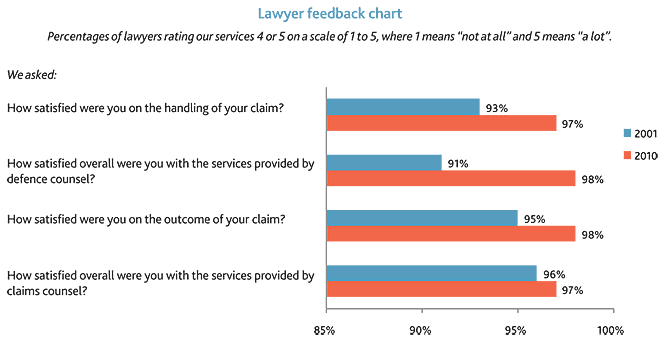
2011 and beyond
Both the number and cost of claims increase when the economy stalls. With the economy still in flux, the negative impact of the downturn on claims is expected to continue. Cost-effective claims management by LIF and a modest fee adjustment will help offset the negative claims experience.
As always, though, preventing claims remains the most effective means of keeping the cost of the program in check. And claim prevention is the result of lawyers embracing the systems and strategies for themselves, and their staff, that will help lead them to a claims-free future.